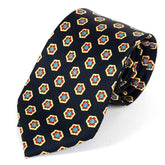Upgrade Your Style with the Pratt Tie Knot: Step-by-Step Tutorial

The Pratt Tie Knot is a neat and precise tie knot ideal for formal events.
About Pratt Tie Knot
Overview of the Pratt tie knot
- Recommended collar types: Narrow point and button-down collars
- Formality level: Suitable for business-casual or social settings
- Difficulty level: Simple
- Symmetry: Yes
- Knot size: Medium (moderately small)
The Pratt knot tie is a variation of the Windsor knot. It is known for its symmetrical, medium size. It is between the Windsor and Four-in-hand knots in size and uses less fabric than a full Windsor.
The Pratt knot complements silk ties of standard width, lighter fabrics or thicker knit neckties, ensuring a balanced and polished look. This knot is highly versatile and suitable for almost any semi-formal or formal occasion, such as business functions, cocktails, and weddings. It's convenient when you're pressed for time but must still dress up.
This knot is particularly flattering for individuals with moderately sized faces. Unlike the Windsor knot, which can overwhelm some faces, the Pratt knot tends to complement their proportions.

Opt for light to medium-weight fabrics with the Pratt Knot to achieve the best look.
Thanks to its medium size, the Pratt tie knot pairs well with button-down and spread collars. It doesn't overpower these collar types like the Windsor can. Overall, the Pratt knot is timeless and stylish for any man looking to enhance his neckwear repertoire.
History of Pratt tie knot
The Pratt tie knot has an intriguing backstory. Former US Chamber of Commerce employee Jerry Pratt is often credited as its originator, though some argue news anchor Don Shelby played a significant role in popularising it. This is why it's also known as the Pratt-Shelby knot.
Pratt tie knot gained attention when 92-year-old Pratt visited Shelby during a telecast and skillfully adjusted Shelby's tie, impressing him with how effortlessly he created the dimple. Shelby then wore it on air, catching the eye of New York fashion writers who hailed it as a "new" knot. From then on, it became a staple in Shelby's on-air wardrobe.

Jerry Pratt popularised the Pratt Knot during his career.
However, the Pratt tie knot's history dates back to the early 20th century. Tailors in Milan have used it since at least the 1920s, initially as a quick method to tie neckties on mannequins for display, leading to another nickname: the Milanese knot.
Step-By-Step Pratt Tie Knot Instructions
Interested in learning how to tie a Pratt knot? Follow our step-by-step guide for easy instructions on achieving this classic and stylish necktie knot.

Instructions for Tying the Pratt Knot (the Shelby Knot).
- Step 1: Start with the backside of your tie facing outwards. Place the wide end on the right side and the narrow end on the left. Position the narrow end so that it sits just above your belly button. Only the wide end will be active during the tying process.
- Step 2: Move the wide end underneath the narrow end towards the left.
- Step 3: Bring the wide end to the centre, aiming towards the neck loop.
- Step 4: Pull the wide end through the neck loop and let it drop to the left.
- Step 5: Move the wide end horizontally across the front of the narrow end to the right.
- Step 6: Bring the wide end up again, from underneath, towards the neck loop.
- Step 7: Pull the wide end down through the loop you created in the front.
- Step 8: To finish, tighten the knot by pulling down on the wide end. Then, slide it up towards your collar to adjust it.
Styling tips: To style a Pratt tie knot correctly, start with the wide end, which is much lower than the skinny end. This ensures the finished tie length is short enough. Adjust the wide end to your preferred length before achieving the right look.
If you need help with how to tie a Pratt knot or seek more style tips for men's ties, contact TieDoctor for expert guidance and personalised advice on achieving the perfect knot for any occasion.



